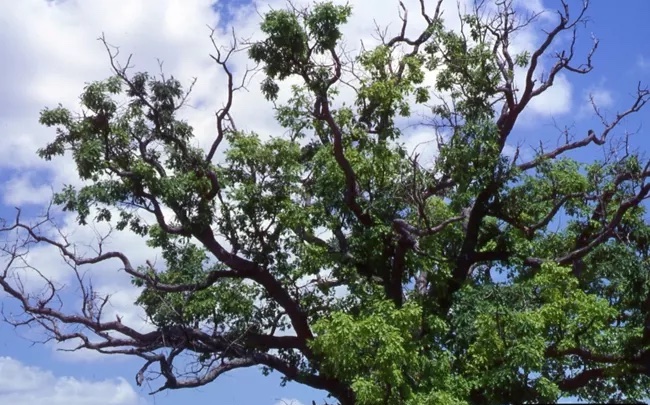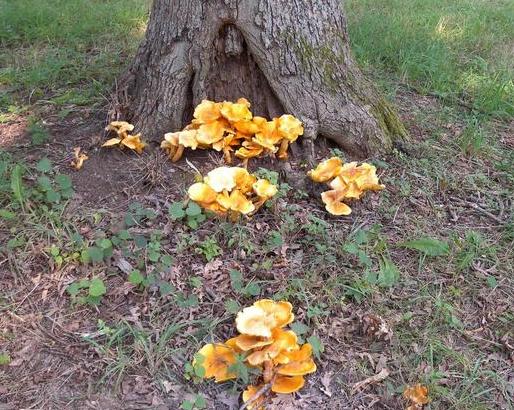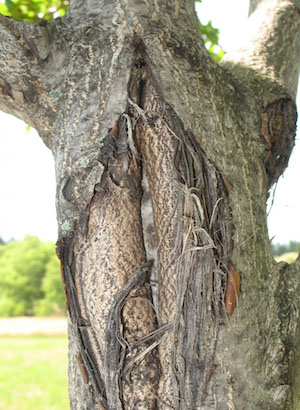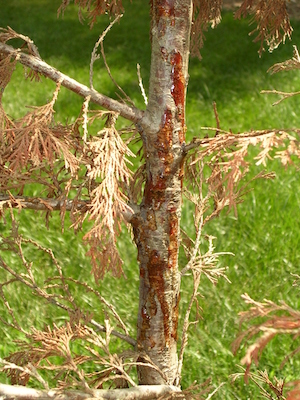How to Evaluate the Health of Your Trees
by Ann M. Mason, Fairfax Master Gardener

Defoliated limbs symptomatic of decline in mature red oak
Trees add value and improve the environment around your home. Tall, mature trees can cause worry, too. Gardeners can take a critical look at the trees in their urban location by knowing a couple of tips to evaluate the health of their trees. After all, informed gardeners can better respond to the door-to-door salespeople that offer to trim or take down their trees, especially if they see a tree or shrub with naked branches.
Let’s take a look at the advice offered by some urban foresters to address the question: Is my tree dying?
To start, we need to acknowledge that like all living things, trees will eventually die. Usually, tree death happens after a slow, often years long, decline. Experts studying tree decline and death report that the cause is often the complex interaction of multiple factors, including changes in the tree’s environment leading to stress in the tree. This invites organisms, usually opportunistic pathogens or pests, to settle in for a long stay. Stressed trees are often unable to fight off these always present invaders.
One question Master Gardeners often receive is how a gardener can recognize tree decline. Urban foresters have a few visual pointers of the visible roots, trunk, limbs and leaves that should prompt the gardener’s closer scrutiny.

Fungal fruiting bodies at the root system of a tree
Look on the ground around the tree
Do you see mushrooms or other fungi growing on the ground around the tree? These could be signs of rot in the root system. Unfortunately, root decay is not reversable. It is best to have your tree evaluated by a certified arborist.
Inspect the place where the tree trunk meets the soil. Is the bark damaged by lawn maintenance machines or other abrasion? Damage to the tree trunk limits the movement of water and nutrients supporting tree growth leading to diminished vigor and structural instability.
As you look at the soil level around the tree trunk, you should see the flare where the roots emerge from the trunk. Covering the root flare with mulch or damaging these exposed roots can lead to decline and death. Covering the root flare keeps the roots too moist encouraging insect and diseases. Gardeners should keep mulch 3 inches away from the tree trunk, and the root flare should be exposed.
Look at the tree trunk
Do you see mushrooms or conks, woody-looking, semicircular bodies that appear as a bracket, shelf shaped or hoof shaped growth out of the tree trunk? Mushrooms and conks are fruiting bodies of fungi that can invade tree tissue in broken branches, cracks in the bark, scars and other wounds. These fruiting bodies can cause decay.
Fungi in the phylum, Basidiomycota, which some experts report contains over 40,000 species, can cause either brown rot or white rot. White rot fungi break down lignin and cellulose causing the wood to appear whiter than its normal color. Brown rot fungi tends to ignore lignin and prefers to feed on cellulose in the cell wall. This causes wood to crack across the grain.

Open wound in tree bark
Do you see swollen, flattened, cracked, round or irregular areas, leaf scars, growth cracks or an open wound? These are locations where the gardener can look for cankers caused by colonies of fungi or bacteria feeding on wood. There are many different species that grow in open wounds and cause injury.
Botryosphaeria sp. fungi is not host-specific and can infect many stressed common landscape woody plants, including dogwood (Cornus), honey locust (Gleditsia triacanthos), rhododendron, sweetgum (Liquidambar styraciflua), oak (Quercus) and more. Virginia Tech reports that visual symptoms of this fungus include wilting or dieback of a branch or branches of a tree or shrub. Another symptom is wood under removed bark having a brown to reddish brown appearance (instead of white). On smooth barked trees like crabapple (Malus), the stems may appear blistered. Resin or gum may ooze from a cankered area in sweetgum, and members of the Prunus family. Cankers may cause bark to peel and drop.
Cankers in spruce (Picea), pine (Pinus), poplars (Populus) and willows (Salix), especially older stressed trees, are often caused by Cytospora cankers, such as the fungus Leucostoma kunzei. According to the University of Maryland Extension, these cankers appear as reddish brown resin oozing from the wood. At the edge of this resinous ooze appear small black spots, which are the fungal fruiting bodies. Attracted to the wound, beetles, spider mites and scale cause secondary infestations.

Resinous ooze from tree bark
Cankers on juniper (Juniperus), Russian olive (Elaeagnus angustifolia), Douglas fir (Pseudotsuga menziesii) and arborvitae (Tsuga) are often caused by Phomopsis cankers. These cankers occur on stressed trees and plants, starting as small dead areas on branches and shoots. According to the University of Illinois Extension, these cankers can appear as sunken areas with darker margins that can grow together to girdle the branch, leading to death of the tissue from that point to the branch tip.
Cankers on honey locust (Gleditsia triacanthos), oak (Quercus) and maple (Acer) are often caused by Nectria cankers, which according to Penn State Extension are often seen as salmon, pink or cream-colored fungal fruiting bodies, shaped like small cushions. These fungal bodies usually are seen in spring and early summer in cracks in the bark.
Look upward to the tree crown
Do you see defoliated limbs, dieback, misshaped or smaller than normal leaves? While seasonal drought, or stress from disease, insects or damage may cause issues, according to the University of Georgia Extension, early leaf loss can signal either a temporary stress or a more serious problem. On the other hand, dieback symptoms of defoliated limbs or naked twigs in the tree canopy may indicate a lack of nutritional flow within the tree to the crown.
Have Questions? Contact a Certified Arborist
Professionals trained and certified in tree care are readily available within the Mid-Atlantic Region. Calling a trained professional for an evaluation can help the gardener assess the overall health of trees, determine the appropriate course of action for stresses or diseased trees and may prevent tree hazard around property and people.
Love Your Trees
Stressed trees and woody plants have a hard time fighting off the always present diseases, pathogens and insects. Gardeners can reduce trees stress by watering, mulching properly, pruning properly and avoiding damage to roots and bark.
Resources
Why Hire a Certified Arborist? Mid-Atlantic Chapter of the International Society of Arboriculture
Is My Tree Dying? University of Georgia Extension, M.C. Sheffield, E. Bauske, W. Hutcheson, B. Pennisi, UGA Circular 1100, University of Georgia Extension
Botryosphaeria Canker and Dieback of Trees and Shrubs in the Landscape, Elizabeth Bush, 450-726, Virginia Cooperative Extension
Hungry Fungi: White-Rot Fungi Eat All Components of the Wood They Decompose, Office of Science, Biological and Environmental Research, US Dept. of Energy
Phomopsis Cankers, Diane Plewa, University of Illinois Extension
Cytospora Canker of Spruce Trees, University of Maryland Extension
Nectria Canker, Gary W. Moorman, Penn State Extension